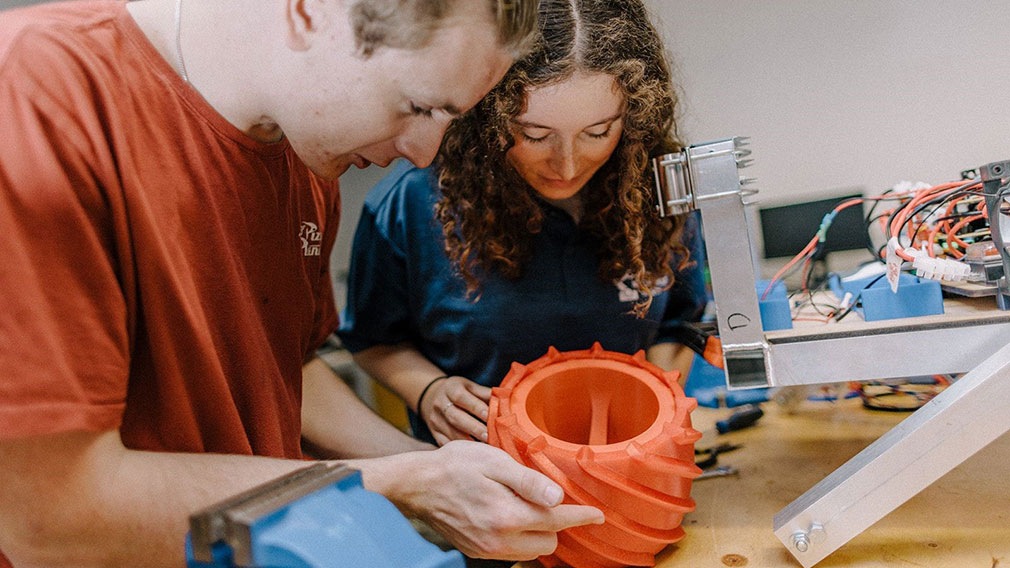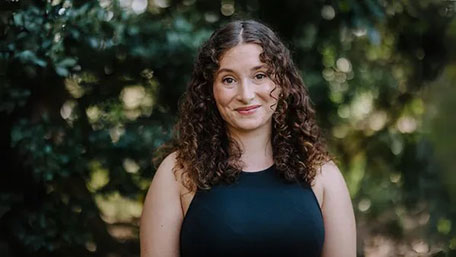This Martian-inspired space scientist is on a mission

Georgi Coddington (pictured right) and colleague work on a lunar rover prototype. (Supplied)
When Matt Damon drove his rover across the vast dunes of Mars in the 2015 blockbuster movie The Martian, it lit a spark in Georgi Coddington.
“I was obsessed with it – I needed to know everything about it,” the University of Wollongong engineering student and Westpac scholar says of the planetary vehicle.
It got her thinking about what might be possible for interstellar exploration in her own time, and this year she was part of a team that took part in the Australian Rover Challenge – an international robotics competition held annually by the University of Adelaide to design and build semi-autonomous lunar rovers.
Australia is already making a mark in this area. The Australian Space Agency’s Trailblazer Program is developing a vehicle - dubbed “Roo-ver” - to go on future missions to the moon with NASA.
Roo-ver will collect soil samples from which NASA will attempt to extract oxygen – a key step towards establishing a sustainable human presence on the moon.
Roo-ver is one of many exciting projects underway in the country’s space industry, and Coddington says there’s a general lack of awareness among the public about the sector’s potential.
That’s something she wants to address, and her specific focus is on inspiring more young people to consider studying and working in disciplines related to space.
Coddington is director of the Astra Program, part of the Australian Youth Aerospace Association, which organises a summer program for tertiary students and young professionals to help them learn about key issues in the Australian space industry and contribute potential solutions.
“What’s great about Astra is that it doesn’t matter what disciplinary background you’re from, it gives you an avenue to explore your passions and do valuable research on topics that you’re interested in.”
Over the course of the program, which runs from November to March, participants are split into teams to work on research papers which they present to relevant government agencies, industries and academic institutions.
Topics covered in this year’s program include strengthening Australia’s critical space infrastructure; advancing life on earth through space; and creating a diverse and inclusive workforce for Australia’s space future.

Georgi Coddington. (Supplied)
Georgi will present a paper at the International Astronautical Congress in Milan later this year on how Astra can be a model for space education programs across the globe.
“There’s nothing like Astra that I’ve seen so far, and programs like this are really important,” she says. “Young people need a community of vibrant, motivated, passionate people that are like them.”
While Australia’s top universities run some excellent courses, the experts teaching them are often older and the environment is more formal, Coddington notes.
Young people benefit from seeing people of a similar age succeeding in the industry, and she points to Katherine Bennell-Pegg – Australia’s first female astronaut – as a great role model for educating and inspiring young Aussies.
“Growing up in a rural area on a farm in Barwang (northwest of Canberra), I never really knew that I could get into the space industry so changing that narrative is really important,” she says.
Recalling her love of The Martian (she’s read the book and watched the movie countless times), Coddington is also mindful of the power of popular culture in firing the imagination. From Star Wars and Star Trek to Blade Runner and the Alien movies, there’s an endless fascination with space and its vast unknown potential.
“This generation is so invested in social media and if you can integrate space into that and on TikTok and in movies it’s really great way to get people interested,” she says.
As for her own future, Coddington is keen to pursue her studies in space-related areas. In particular, she’s fascinated by planetary orbits and what they can tell us about how the universe works.
In 2024, Coddington became a Westpac Scholar, and through the program she is spending one semester at Nanyang Technical University in Singapore.
“I’m keen to help Australia develop its relationship with Asia in the space sector, and how we can do that through topics covered in the Astra Program.”
She sees potential for further collaboration across the region on innovative technologies like Earth Observation Satellites for monitoring of natural disasters, and how they can help response teams to better allocate resources.
Coddington’s big mission is to raise awareness of the potential of Australia’s space industry to add value to the economy, as well as creating stimulating, highly skilled jobs.
For example, the Technology Safeguards Agreement with the US, which came into effect in July, paves the way for US space technology like rockets and satellites to be launched from Australia.
With the TSA in place, the government estimates that Australian spaceport operators could supply between 45 and 95 space launches over the next decade with a value of up to $1.2 billion.
“A lot of young people think that if they want to work in the space industry they have to go and work at NASA, so it’s important for them to be able to see the potential that we have here,” Coddington says.
“It’s a great industry to be in and we want more people, especially young people, to be a part of that.”
The Westpac Scholars program funds 100 scholarships every year, helping participants to further their studies as well as providing leadership development opportunities, global experiences, networking and mentoring.


